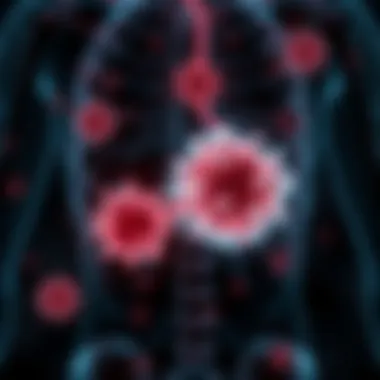Understanding Stage 3 Cancer: Implications and Insights


Intro
Stage 3 cancer often represents a pivotal moment in a patient's journey, marking a transition from early detection to intensive treatment. It reflects a scenario where the disease has spread significantly, demanding not just medical intervention but also emotional resilience and support from various sources. The implications of this stage are manifold, touching both the biological aspects of cancer management and the psychological toll it exerts on affected individuals and their support networks.
Understanding what Stage 3 entails is crucial for patients and families alike. Patients often find themselves at a crossroads, facing tough choices regarding their treatment options while grappling with the reality of their prognosis. These decisions are compounded by the complexities of the disease, and a thorough grasp of the stage's characteristics can aid in navigating through these challenges.
In this article, we shall explore the framework surrounding Stage 3 cancer, delving into its characteristics, diagnostic methods, available treatment options, along with the psychosocial ramifications faced by patients and their families. This insight will arm readers with the knowledge to better grasp the intricacies and potential outcomes associated with this advanced stage of cancer.
Definition of Stage Cancer
Understanding the definition of Stage 3 cancer is crucial for both patients and their support systems. At this advanced stage, the cancer has typically spread beyond its original location and has begun to impact surrounding lymph nodes or other regions of the body. This particular staging has direct implications for treatment options and prognosis since it signifies a more aggressive form of the disease.
Understanding Staging in Oncology
Staging in oncology is like putting together a complex puzzle. It helps healthcare providers ascertain the extent of cancer spread, guiding effective treatment plans. The most widely used system is the TNM system:
- T (Tumor): Indicates the size and extent of the primary tumor.
- N (Nodes): Refers to whether the cancer has spread to the nearby lymph nodes.
- M (Metastasis): Indicates the presence of metastasis in distant organs or tissues.
For Stage 3 cancer, at least one of these indicators points towards significant advancement. It is vital to understand this staging as it enables doctors to categorize the disease properly, tailoring treatment strategies that are specific to each patient's unique situation, maximizing their chances of recovery.
Characteristics of Stage Cancer
Stage 3 cancer is often marked by clear, pronounced characteristics that differentiate it from earlier stages. Here are some notable traits:
- Tumor Size: The tumor is likely larger, measuring several centimeters, and may be growing aggressively.
- Local Lymph Node Involvement: Stage 3 cancer frequently signifies that regional lymph nodes are affected, which can differ based on the cancer type.
- Symptoms: Patients might experience more noticeable symptoms, such as pain or discomfort, fatigue, and unexpected weight loss.
These characteristics not only serve to define the stage but also play a significant role in clinical decision-making. Knowing these traits can help patients and families prepare for the journey ahead, from treatment choices to emotional support needs.
"Awareness of cancer staging fosters a more informed dialogue between patients and healthcare providers, enabling a better understanding of treatment pathways."
Grasping the nuances of Stage 3 cancer paves the way for a more comprehensive approach to care, involving multiple specialties, and fostering better outcomes. This understanding is essential not only for treatment strategies but for discussions about prognosis and long-term care.
Types of Cancer and Stage Classification
Understanding the types of cancer that progress to stage 3 is crucial for both patients and healthcare professionals. Stage 3 signifies a point where cancer has spread more extensively than earlier stages and often calls for comprehensive treatment strategies. The different types of cancer can exhibit varying characteristics at this stage, which can significantly influence treatment options and prognostic outcomes. A clear grasp of these classifications allows healthcare providers to tailor interventions specific to individual circumstances, enhancing the effectiveness of care.
Breast Cancer: A Closer Look
Breast cancer that reaches stage 3 is often categorized as locally advanced. This means it has spread beyond the breast and nearby lymph nodes. Women diagnosed with this stage face a complex journey, as the tumor size and lymph node involvement are significant considerations. Tumors may range widely in size, and any lymph nodes involved can complicate treatment. For example, if a tumor has grown to larger than 5 centimeters, or many nearby lymph nodes are affected, it can dramatically shift treatment strategies.
In most scenarios, neoadjuvant chemotherapy is often employed, providing a dual benefit: shrinking the tumor before surgery and addressing any potential micrometastases. Awareness of breast cancer at this stage is critical as it not only affects physical health but also emotional well-being.
Lung Cancer Details
Lung cancer, specifically in its stage 3 form, can be classified into two groups: non-small cell lung cancer (NSCLC) and small cell lung cancer (SCLC). In stage 3 NSCLC, the cancer may involve nearby lymph nodes but has not yet spread to distant organs. The implications of this classification are vast; treatment options often involve a combination of surgery, chemotherapy, and radiation therapy due to the aggressive nature of the disease. Furthermore, symptoms such as persistent cough or difficulty in breathing signal the depth of the disease's impact on a patient's quality of life. In contrast, SCLC typically has a poorer prognosis, yet advanced treatments are evolving. Clearly, recognizing the stage and type aids doctors in crafting a personalized therapeutic approach, which can make all the difference across the care continuum.
Colorectal Cancer Insights
When colorectal cancer reaches stage 3, it indicates that the tumor has penetrated through the wall of the colon or rectum and possibly affected nearby lymph nodes. This critical juncture often leads to a multi-faceted treatment plan, frequently involving adjuvant chemotherapy after surgical resection. The monitoring of these areas during treatment is essential, as it can reveal whether cancer has recurred in the lymph nodes, greatly affecting prognosis. From a patient perspective, understanding stage 3 colorectal cancer means grappling with dietary changes and lifestyle adjustments post-diagnosis. Awareness and education about how this stage manifests can empower patients to make informed choices regarding their treatment and recovery phases.
Stage 3 cancer highlights the importance of prompt diagnosis and tailored treatment approaches to increase patient survival outcomes.
Examining the types of cancer and their correlating classifications not only heightens awareness regarding stage 3 but also fosters deeper connections between patients and their healthcare teams. This understanding plays a fundamental role in navigating the complexities of treatment and quality of life adjustments that come with such significant diagnoses.
For more detailed insights about different types of cancer, resources like National Cancer Institute and American Cancer Society provide invaluable information.


Diagnostic Approaches for Stage Cancer
Diagnosing stage 3 cancer is a intricate process that involves multiple methods aimed at accurately determining the extent of tumor spread. This stage, often characterized by significant growth and possible invasion into surrounding tissues or lymph nodes, necessitates precise diagnostic approaches. The information gathered from these assessments not only aids in staging but also significantly influences treatment plans and patient outcomes. Understanding these diagnostic approaches is essential for patients and healthcare professionals, as it helps in making informed decisions and setting appropriate expectations.
Imaging Techniques
Imaging techniques stand as foundational pillars in the diagnosis and staging of cancer. These non-invasive methods provide visual insights into the tumor's size, location, and the involvement of nearby structures. A few commonly used imaging methods include:
- CT Scan: A computed tomography scan offers detailed cross-sectional images of the body, allowing doctors to see the shape and size of tumors. It is particularly effective in identifying lymph node involvement which is crucial for stage 3 classification.
- MRI: Magnetic resonance imaging uses powerful magnets and radio waves to create detailed images, particularly useful for diagnosing cancers of the brain and spinal cord. This technique helps in evaluating how far the cancer has spread into surrounding tissues.
- PET Scan: Positron emission tomography is specialized in detecting cancerous cells based on their metabolic activity. This scan can highlight areas of high cancer activity, assisting in assessing both initial staging and response to treatment.
The integration of these imaging techniques allows for a more comprehensive understanding of the cancer's progression. However, one should consider potential drawbacks such as exposure to radiation in CT scans or the availability of advanced machines like PET scans.
"Imaging modalities are a window into the body, giving us critical information that guides the course of treatment."
Biopsy Procedures
Biopsy procedures represent the gold standard for confirming a cancer diagnosis. While imaging helps in staging, a biopsy provides histological evidence, confirming whether a tumor is malignant or benign. There are several types of biopsy procedures used for stage 3 cancer diagnosis:
- Fine Needle Aspiration (FNA): This is a minimally invasive method where a thin needle extracts cells from a mass. It is often used for superficial tumors or lymph nodes.
- Core Needle Biopsy: Slightly more invasive than FNA, this method uses a larger needle to remove a core of tissue. It gives more tissue for analysis and provides a better representation of the tumor’s architecture.
- Surgical Biopsy: In some cases, a larger sample may be necessary. A surgical biopsy, either excisional or incisional, might be performed. This approach can facilitate not only diagnosis but also a preliminary assessment of how much cancer has invaded surrounding tissue.
The choice of biopsy method depends on the tumor type, location, and the clinical setting. Each technique has its own risk profile and implications for the patient, which must be factored into the decision-making process. Understanding the intricacies of these diagnostic techniques enhances the ability to manage stage 3 cancer effectively and underscores the importance of a tailored approach to each patient's circumstances.
Treatment Options for Stage Cancer
Treatment options for stage 3 cancer are pivotal as they often dictate the patient's path towards managing the disease effectively. This stage signifies a serious point where the cancerous cells have spread beyond the original tumor site, making timely and effective intervention crucial. This section will touch on surgical interventions, chemotherapy protocols, and radiation therapy applications—each playing a distinct role in crafting a comprehensive treatment regimen.
Every option carries its own set of benefits and considerations. The selection of a treatment plan depends on several factors: the type of cancer, the patient's overall health, and personal preferences. Understanding these treatment avenues enables patients and caregivers to make informed choices in what can be a daunting period.
Surgical Interventions
Surgical interventions typically aim to remove the malignancy and any surrounding tissue that might harbor cancer cells. This option often brings the possibility of a significant reduction in tumor size or even achieving a state of remission.
Patients might undergo:
- Resection: This involves excising the tumor entirely if it is operable. For example, surgical resection is common in lung and breast cancer cases where the tumor is localized enough that surgery can be performed without excessive risk.
- Debulking procedures: In cases where complete tumor removal isn’t feasible, surgeons may perform debulking to remove as much of the tumor as possible, making subsequent treatments like chemotherapy more effective.
Factors influencing the surgical choice include the tumor’s location, size, and the patient's overall health. It's essential to have thorough discussions with oncological surgeons to weigh the pros and cons.
"Surgery can be both curative and restorative, providing hope and prolonging life when treated appropriately."
Chemotherapy Protocols
Chemotherapy is often a primary treatment for stage 3 cancer. This systemic therapy uses drugs that target rapidly dividing cells, aiming to kill cancer cells throughout the body. It may be administered as neoadjuvant therapy (before surgery) or adjuvant therapy (after surgery).
Several key points about chemotherapy:
- Combination regimes: Often, oncologists prefer a cocktail of drugs tailored to the specific cancer type, which can enhance effectiveness. This might involve medicines such as doxorubicin or cyclophosphamide in breast cancer or cisplatin in lung cancer.
- Side effects management: Patients may face side effects ranging from nausea to fatigue, but managing these effects is essential for maintaining quality of life during treatment. Fortunately, supportive medications can greatly alleviate such discomforts.
Radiation Therapy Applications
Radiation therapy serves as a localized treatment option, applying high-energy waves to target and destroy cancer cells. In stage 3 cancer, radiation may be used as a standalone treatment or in concert with surgery and chemotherapy.


Different approaches include:
- External beam radiation therapy (EBRT): A common method where the radiation is directed from outside the body to the tumor site, minimizing harm to nearby healthy tissue.
- Brachytherapy: This technique involves placing radioactive material directly inside or very close to the tumor. It is often utilized for cancers like prostate and cervical cancer.
- Palliative radiation: In cases where relieving symptoms is vital, radiation can help shrink tumors that cause discomfort or pain, enhancing the patient’s quality of life.
Survival Rates and Prognostic Factors
Understanding survival rates is vital for anyone navigating the complexities of stage 3 cancer. These metrics serve as a beacon, guiding patients and families through the fog of uncertainty that often accompanies a cancer diagnosis. Survival rates can provide clarity about what lies ahead, empowering patients with knowledge about their situation.
Survival rates are often expressed as a percentage, indicating the fraction of people who survive a specific type of cancer for a designated timeframe, typically five years after diagnosis. This timeframe doesn’t mean one’s battle with cancer ends after five years; rather, it serves as a standard measure to assess progress and treatment effectiveness.
It’s essential to know that these rates are based on populations, and individual prognosis can vary significantly. Factors such as a patient’s age, overall health, and specific cancer characteristics play a crucial role in their unique journey. Without understanding these metrics, one might confront the emotional challenges of living with cancer without clear expectations or hope. As such, they can aid in making informed decisions regarding treatment plans and lifestyle choices.
"Survival statistics can be a critical component of navigating cancer, offering essential insight into potential outcomes while highlighting the importance of a personalized approach."
Understanding Survival Metrics
The realm of survival metrics encompasses a few specific types. The two most common ones include the relative survival rate and observed survival rate. The relative survival rate compares the survival of cancer patients to the expected survival of people in the general population, while the observed survival rate directly measures the percentage of patients surviving over time, regardless of their cancer status.
Besides these, the stage-specific survival rate is particularly relevant for stage 3 cancer, as it reflects the outcomes specifically for this stage alone. For example, in stage 3 breast cancer, survival may vary significantly among different patients due to factors like tumor size, lymph node involvement, and histological subtype.
Key Considerations
- Variability: No two cancer experiences are identical. While statistical data provides a general guide, personal variables can lead to vastly different outcomes.
- Updates in Treatment: As cancer research advances, newer therapies might improve survival statistics over time.
Factors Influencing Outcomes
Survival rates are not set in stone; rather, they are influenced by an array of factors. Understanding these can demystify why two individuals with the same diagnosis may experience entirely different journeys. Here are some of the significant elements:
- Tumor Characteristics: The type of cancer, its grade, and pathology significantly impact prognosis. Higher-grade tumors typically indicate a more aggressive disease, which can correlate with poorer outcomes.
- Patient Health: Pre-existing health conditions, age, and overall wellness often affect both treatment response and recovery.
- Response to Treatment: How well a patient responds to initial treatments, such as chemotherapy or radiation, can signal potential outcomes. Those who respond positively may have a better prognosis.
- Genetic Factors: Personalized medicine increasingly focuses on genetic markers that can influence survival and treatment efficacy. Some mutations or variations may provide insight into a patient’s specific disease behavior.
These factors underscore the importance of personalized care, where treatment plans are tailored to address an individual’s unique circumstances rather than a blanket approach.
For further reading on the dynamics of cancer treatment and survival rates, resources like the American Cancer Society (cancer.org) and National Cancer Institute (cancer.gov) provide invaluable insights.
Psychosocial Implications of Stage Cancer
Stage 3 cancer represents a profound diagnosis that extends beyond the physical realm, deeply affecting the emotional and social fabric of patients and their families. The importance of understanding the psychosocial implications of such a critical condition cannot be overstated. Patients may experience a spectrum of emotions, from despair to anger, as they grapple with the reality of their illness. Recognizing these challenges allows for a more compassionate approach to care, addressing not only the disease but also the holistic needs of those affected.
- Emotional Responses: Patients often go through phases of fear, uncertainty, and even guilt. They're faced with a myriad of questions: "What's going to happen to me?" or "How will my family cope?" These internal battles can lead to feelings of isolation and helplessness.
- Impact on Relationships: Cancer doesn’t just affect the individual; it ripples through family and friends, altering dynamics and social interactions. Understanding this can guide support mechanisms that help maintain open communication and emotional closeness during such trying times.
- Need for Support: Comprehensive care should include mental health support. This might mean counseling, support groups, or even access to resources like palliative care teams that specialize in guiding patients and families through this difficult journey.
"The psychological impact of cancer can linger well after treatment. Fostering an environment that encourages discussion and expression of feelings is crucial for healing."
By delving into the psychosocial landscape of stage 3 cancer, healthcare providers, families, and friends can create a supportive network that empowers patients to confront their challenges with resilience.
Emotional Challenges for Patients
Patients diagnosed with stage 3 cancer often find themselves navigating turbulent emotional waters. There are moments when waves of anxiety and fear seem insurmountable, making it difficult to focus on treatment or future plans.
- Fear of the Unknown: Facing the prospect of an uncertain future is one of the most daunting aspects of a cancer diagnosis. Patients may worry about the effectiveness of treatments and their long-term prognosis, leading to anxiety that can overshadow daily life.
- Diagnosis Shock and Acceptance: The moment of diagnosis can feel surreal, much like stepping into a different world. Some may experience denial, while others might swiftly come to terms with their situation, moving through their emotional journey at different paces.
- Depression and Isolation: The combination of treatments, the physical toll of the disease, and the fear of social withdrawal can create a shadow of depression. Patients often feel isolated from friends and everyday life, further complicating their emotional health. It’s vital to encourage engagement in social activities, as isolation can exacerbate mental health issues.
Proactive measures, such as mental health counseling or peer support groups, where patients can share their experiences and feelings, can significantly help navigate these emotional challenges.


Family Dynamics and Support Systems
Families play a crucial role in the support system for stage 3 cancer patients. The dynamics of family relationships can undergo significant transformations during such a stressful time, often revealing strengths and vulnerabilities in ways few could have imagined.
- Communication is Key: Open discussions about fear and uncertainty can create a stronger bond between family members. It can alleviate feelings of isolation for the patient and help families process their feelings collectively.
- Role Reversal and Responsibilities: Often, the caring role shifts within families, with partners or children taking on caregiving responsibilities. This shift can produce stress and strain, necessitating clear discussions about roles and responsibilities.
- Seeking Help Together: Families may benefit from professional counseling to provide strategies to cope effectively with their loved one’s diagnosis. Support groups specifically for family members can also provide necessary insights into navigating the new reality of their lives.
In summary, understanding the psychosocial implications of stage 3 cancer elicits a comprehensive approach to care. By addressing emotional challenges and fostering healthy family dynamics, patients and their families can empower themselves, fostering resilience and unity in the face of adversity.
Research and Future Directions
Research and future directions in the realm of stage 3 cancer are paramount, as they shed light on new treatments and innovative approaches that can significantly alter the patient's journey. The importance of ongoing research cannot be overstated; it cultivates hope and provides a roadmap for better outcomes. Understanding how treatment paradigms are evolving offers both patients and healthcare providers insight into the potential next steps in management.
Recent Advances in Treatment
In recent years, treatment for stage 3 cancer has witnessed substantial progress. These advances revolve around multiple facets, from immunotherapy to targeted therapies.
- Immunotherapy: This groundbreaking approach leverages the body's immune system to combat cancer cells. Research has shown that certain immunotherapies can improve survival rates and reduce tumor sizes, especially in cancers such as melanoma and lung cancer.
- Targeted Therapies: Unlike traditional chemotherapy, which often affects both healthy and malignant cells, targeted therapies aim specifically at cancer cell mechanisms. This specificity not only enhances effectiveness but also can lead to a decrease in side effects.
- Combination Therapies: There’s an increasing trend towards utilizing combination therapies, where treatments like chemotherapy, radiation, and immunotherapy work together. This multi-faceted approach can potentially offer a more comprehensive assault on the cancer.
Advances in treatment show that a collaborative strategy may enhance efficacy and improve patient quality of life.
Research continues to explore the genetic underpinnings of various cancers, leading to personalized treatment plans that consider the unique makeup of the tumor. These efforts hold promise for making stage 3 diagnoses less daunting.
The Role of Clinical Trials
Clinical trials play a crucial role in the future of cancer treatment, particularly for stage 3 cancer patients. These trials help bridge the gap between theoretical research and practical application by testing new therapies in real-world settings.
Participating in clinical trials provides patients access to cutting-edge treatments that may not be available otherwise. Often, these trials focus on:
- New drug therapies: Evaluating the effectiveness and safety of novel compounds in cancer treatment.
- Innovative delivery methods: Exploring alternative methods of treatment administration that might improve absorption and efficacy.
- Biomarker studies: Identifying biomarkers that can predict response to specific treatments, thereby allowing for better-targeted approaches.
However, while the potential benefits are significant, patients should also consider the challenges, including possible side effects and the need for close monitoring. Discussing the pros and cons with healthcare providers can illuminate the best path forward for each individual.
In summary, ongoing research and the exploration of future directions are critical in the fight against stage 3 cancer. As knowledge and technology advance, patients stand to benefit from a more tailored, less invasive, and potentially more effective therapeutic landscape.
Closure: Navigating Stage Cancer
Understanding Stage 3 cancer allows patients, families, and healthcare professionals to make informed decisions in a landscape often clouded with uncertainties. As we reach the conclusion of this detailed exploration, it's vital to recognize that Stage 3 represents a critical period in the cancer journey, marked not just by the disease itself, but by a comprehensive approach to health care. This level of awareness can greatly affect treatment choices, emotional support systems, and the overall quality of life for those involved.
Summary of Key Points
To encapsulate the main themes discussed throughout this section, here’s a recapitulation of fundamental points:
- Significance of Early Diagnosis: Early detection improves options for treatment, often leading to better personal outcomes.
- Diverse Treatment Modalities: Surgical options, along with chemotherapy and radiation, provide tailored strategies that match the unique needs of each patient.
- Psychosocial Considerations: The emotional and social dimensions of coping with Stage 3 cancer are just as critical, highlighting the necessity for support from family and professionals.
- Survival Metrics: Survival rates can vary significantly based on cancer type, stage at diagnosis, and response to treatment, reinforcing the importance of individualized approach.
- Role of Research: Continuous advancements in oncology underscore the need for ongoing education and awareness among patients and practitioners.
"Knowledge is power. Infusion of knowledge is life itself." - An apt reminder that understanding the complexities of Stage 3 can empower individuals with cancer to navigate their experiences better.
The Importance of Individualized Care
When dealing with Stage 3 cancer, one-size-fits-all approaches often fall short. Individualized care ensures that treatment aligns more closely with a patient’s specific circumstances—be it the type of cancer, personal health history, or even psychological profile. Creating an tailored treatment plan can significantly influence outcomes.
Patients benefit immensely from discussions with oncologists who understand their unique situations. This dialogue helps incorporate personal preferences into treatment choices, which may include a blend of conventional and alternative therapies, managing side effects, or even considering clinical trials for access to cutting-edge treatments.
Moreover, recognizing the psychological landscape—such as anxiety, fear, or hope—affects not just treatment adherence but also recovery. When healthcare teams prioritize individualized care, they foster a more collaborative environment, empowering patients not just to be recipients of care but active participants in their health journey. The nuance of understanding individual needs cannot be overstated; it may very well dictate the success of treatment and overall well-being during this challenging time.
For further reading:



